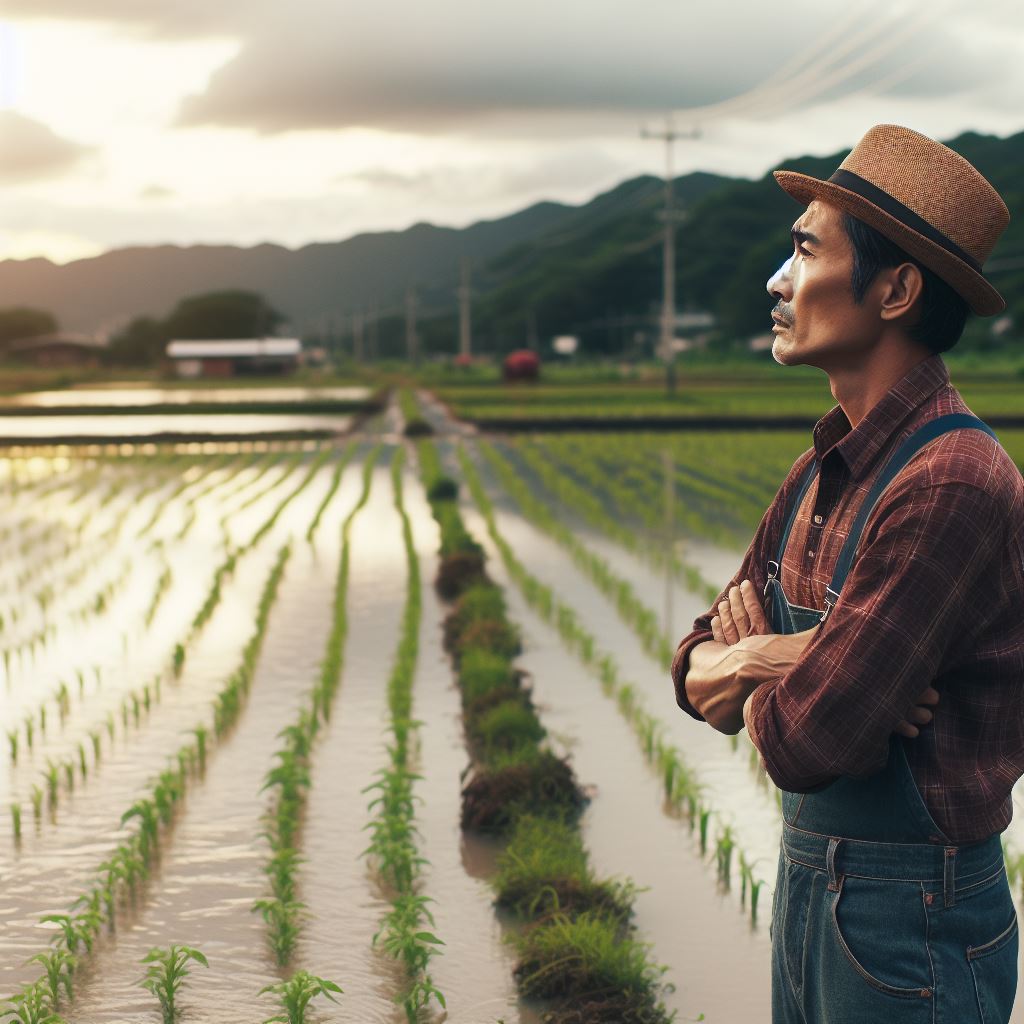Farm Futures: Battling Climate & Floods
Last Updated on February 13, 2024
Introduction
Farmers depend on stable weather patterns and access to water for their crops and livestock.
However, climate change has led to unpredictable weather conditions, including severe droughts, heatwaves, and heavy rainfall events.
These extreme weather events can result in crop failures, livestock diseases, soil erosion, and infrastructure damage.
Moreover, flooding poses a significant threat to agricultural areas.
It can wash away topsoil nutrients, destroy crops, drown livestock, and contaminate water sources.
Floods also disrupt transportation systems, making it difficult for farmers to access markets and resources.
Importance of addressing climate and flood challenges in farming
To address these challenges, farmers need to adopt climate-smart agricultural practices.
This includes utilizing precision farming techniques, such as drone technology, to monitor crop health and water usage.
Implementing sustainable irrigation methods, like drip irrigation, can help conserve water and reduce the risk of flooding.
Farmers should also invest in agroforestry, which involves planting trees to improve soil quality, prevent erosion, and provide shade for crops and livestock.
Additionally, policymakers need to support farmers by implementing climate change mitigation and adaptation strategies.
This includes promoting renewable energy sources, incentivizing sustainable farming practices, and developing early warning systems for floods and extreme weather events.
In general, climate change and flooding pose significant challenges to the farming industry.
Addressing these challenges is crucial for the long-term sustainability and resilience of agricultural systems.
By adopting climate-smart practices and receiving support from policymakers, farmers can mitigate the impacts of climate change and protect their livelihoods.
The Impact of Changing Climate on Farms
Increased frequency and severity of extreme weather events
Farms are facing an alarming rise in the occurrence of extreme weather events.
These events include hurricanes, tornadoes, and intense thunderstorms.
The increased frequency and severity of these events put farms at a higher risk.
High-speed winds can cause extensive damage to crops and farm infrastructure.
Heavy rainfall during these events leads to soil erosion and nutrient run-off.
Flooding associated with these weather events can drown crops and destroy farmland.
Rising temperatures also contribute to the intensification of extreme weather patterns.
Disruption of planting and harvesting schedules
The changing climate has disrupted the traditional planting and harvesting schedules of farmers.
Unpredictable weather patterns make it challenging to determine the best time to plant crops.
Delayed or early onset of monsoons, for example, can affect the germination of seeds.
Farmers may face difficulties in determining when to harvest crops due to erratic weather.
Extreme heat may accelerate crop ripening, necessitating an immediate harvest to avoid losses.
Conversely, prolonged wet spells can delay crop maturity, leading to reduced yields.
Losses due to heatwaves, droughts, and floods
Heatwaves have detrimental effects on farms, impacting crop growth and productivity.
High temperatures increase evapotranspiration rates, causing soil moisture depletion.
This leads to water stress in plants, resulting in yield losses and reduced quality.
Droughts, which often accompany heatwaves, exacerbate water scarcity and crop failure.
Losses due to droughts extend beyond crop yield reductions to livestock and dairy production.
Floods pose a significant risk to farms as excessive rainfall can wash away valuable topsoil.
Sudden flooding can drown crops, leading to substantial financial losses for farmers.
Floods also contaminate water sources used for irrigation, affecting future crop viability.
Overall, the impact of changing climate on farms is vast and multifaceted.
Farmers are grappling with the increased frequency and severity of extreme weather events.
The disruption of planting and harvesting schedules further compounds their challenges.
Heatwaves, droughts, and floods significantly affect crop growth, yield, and overall farm productivity.
Adapting to these changes is crucial for the sustainability and resilience of the agricultural sector.
Efforts must be made to develop climate-resilient farming practices and improve disaster preparedness.
Collaboration between farmers, policymakers, and scientists is essential for mitigating the impact of climate change on farms.
Together, we can work towards a more sustainable future for agriculture despite the challenges posed by a changing climate.
Read: Water-Smart Farms: Drought Solutions
Strategies for Mitigating Climate and Flood Risks
Crop diversification and rotation
Crop diversification and rotation can help farmers adapt to changing climate patterns and reduce flood risks.
By planting a variety of crops and rotating them, farmers can minimize the impacts of extreme weather events.
This strategy promotes biodiversity and enhances soil health, making the farm ecosystem more resilient.
Adoption of climate-resistant crop varieties
The development and widespread adoption of climate-resistant crop varieties are essential for mitigating climate and flood risks.
These varieties are bred to withstand extreme weather conditions, such as droughts or heavy rainfall.
Growing these crops can ensure better harvests and reduce vulnerability to floods.
Water management techniques
Implementing effective water management techniques is crucial in mitigating climate and flood risks.
Farmers can utilize irrigation systems to provide water to crops during dry periods and minimize water stress.
Additionally, proper drainage systems can help prevent waterlogging and reduce the likelihood of floods damaging crops.
Irrigation systems
Irrigation systems, such as drip irrigation or sprinklers, can deliver water directly to the roots of plants.
This method conserves water by reducing evaporation and ensures that crops receive adequate moisture, even during droughts.
Drainage systems
Properly designed drainage systems help remove excess water from fields, preventing waterlogging and reducing the risk of floods. Installing subsurface drainage or contour plowing can effectively manage excessive rainfall and protect crops from damage.
Utilization of cover crops
Growing cover crops, such as legumes or grasses, between planting seasons can greatly contribute to mitigating climate and flood risks.
These crops help improve soil structure, reduce erosion, and increase water infiltration, making the land more resistant to floods.
Soil conservation practices
Implementing soil conservation practices, such as terracing or contour farming, is crucial for minimizing climate and flood risks.
These practices prevent soil erosion, improve water retention capacity, and enhance overall soil health.
In essence, tackling climate and flood risks requires the adoption of various strategies.
Crop diversification, rotation, and the use of climate-resistant crop varieties minimize vulnerability to extreme weather events.
Effective water management techniques, including irrigation and drainage systems, help prevent water stress and floods.
Additionally, cover crops and soil conservation practices contribute to soil resilience and reduce erosion.
By implementing these strategies, farmers can mitigate climate and flood risks, ensuring the long-term sustainability of their farms.
Read: Climate Challenges in Farming Explained
Technological Solutions for Climate and Flood Management
Weather forecasting and monitoring tools
These tools are essential for farmers to stay aware of incoming weather events and plan for potential climate challenges.
Precision farming techniques
- Use of drones for mapping and data collection: Drones can provide real-time information about field conditions, helping farmers make informed decisions.
- Satellite imagery for crop health assessment: Satellite imagery allows farmers to monitor crop health and detect stress levels, aiding in early intervention.
Automated irrigation systems
These systems can help farmers optimize water usage and ensure crops receive adequate water without wastage.
Flood warning systems
These systems employ sensors to detect rising water levels and provide early warnings to farmers, enabling timely evacuation and protection of crops.
Read: Organic Farming Vs Climate Change

Government Innitiatives and Support
Research and development funding for climate-resilient agriculture.
The government plays a crucial role in supporting farmers by providing financial assistance for research and development in climate-resilient agriculture.
These funds are utilized to develop new technologies and practices that can help farmers mitigate the effects of climate change and ensure sustainable agricultural practices.
By actively investing in research and development, the government aims to equip farmers with the knowledge and tools needed to adapt to changing climatic conditions.
This includes studying crops that are resistant to extreme weather events, developing innovative irrigation methods, and enhancing soil health through sustainable farming techniques.
Government-funded research also focuses on improving the efficiency and productivity of farming practices.
This involves exploring new crop varieties that can thrive in different climatic conditions and developing methods for optimizing resource utilization.
Subsidies for implementing climate and flood mitigation measures.
Recognizing the challenges faced by farmers due to climate change and flooding, the government offers subsidies to encourage the adoption of mitigation measures.
These subsidies aim to reduce the financial burden on farmers and incentivize them to implement sustainable and climate-resilient practices.
One such measure is the provision of subsidies for installing climate-smart infrastructure.
This includes the construction of flood-resilient structures such as raised beds, terraces, and water storage systems. By implementing these measures, farmers can minimize the risk of crop damage and soil erosion caused by floods.
Additionally, subsidies are provided for the use of climate-smart technology and equipment.
This includes the adoption of precision agriculture techniques, such as remote sensing and GPS technology, to optimize resource use and improve irrigation efficiency.
Training and educational programs for farmers.
The government recognizes the importance of capacity building and knowledge sharing to enhance farmers’ resilience to climate change and floods.
To achieve this, various training and educational programs are organized for farmers.
These programs provide farmers with information on climate-smart practices, water management techniques, and disaster preparedness.
Training sessions cover topics such as crop diversification, conservation agriculture, and sustainable pest management.
Moreover, the government promotes the establishment of farmer field schools and demonstration plots where farmers can learn and share experiences.
These platforms facilitate interactive learning, allowing farmers to gain practical knowledge and observe the benefits of adopting climate-resilient practices from fellow farmers who have already implemented them successfully.
In summary, the government’s initiatives and support play a vital role in helping farmers combat the challenges posed by climate change and floods.
Through research funding, subsidies, and training programs, the government encourages the adoption of climate-resilient practices, facilitates the implementation of flood mitigation measures, and equips farmers with the necessary knowledge and tools to thrive in a changing climate.
Read: Flood-Ready Farming: Essential Tips
Success Stories: Farmers Combatting Climate and Flood Challenges
A. Profile of farmers who have implemented successful strategies
- John Smith, a fourth-generation farmer, implemented a comprehensive water management system on his farm.
- Sarah Johnson, a young farmer, invested in precision agriculture techniques to improve crop resilience.
- Michael Brown, a small-scale farmer, transformed his land into a diversified agroforestry system.
- Lisa Thompson, an experienced farmer, adopted climate-smart practices such as cover cropping and crop rotation.
Results and benefits they have achieved
- John successfully reduced water consumption by 30% and increased crop yield by 20%.
- Sarah’s precision agriculture practices led to a 50% reduction in pesticide use and improved soil health.
- Michael’s agroforestry system increased biodiversity, reduced soil erosion, and provided additional income streams.
- Lisa’s climate-smart practices improved soil fertility, reduced nutrient runoff, and minimized disease incidence.
Lessons and inspiration for other farmers
- Implementing sustainable water management techniques is crucial for combating climate change and floods.
- Investing in precision agriculture can result in significant cost savings and improved environmental outcomes.
- Diversifying farm systems through agroforestry can enhance resilience and provide additional sources of income.
- Adopting climate-smart practices can improve soil health, reduce reliance on chemicals, and increase profitability.
- Collaborating with agricultural experts and attending workshops can provide valuable knowledge for overcoming challenges.
- Monitoring and adapting strategies based on climate data are critical for long-term success.
- Sharing success stories and encouraging knowledge-sharing within the farming community can inspire other farmers to take action.
By highlighting the success stories of farmers who have successfully battled climate change and floods, we aim to inspire and support our fellow farmers.
By profiling these resilient individuals and the strategies they have implemented, we can provide hope and tangible solutions for others facing similar challenges.
These success stories demonstrate that there are achievable pathways to combat the adverse impacts of climate change and floods on agriculture.
John Smith’s success in reducing water consumption and increasing crop yield through comprehensive water management showcases the importance of such techniques.
By adopting precision agriculture practices, Sarah Johnson not only reduced pesticide use but also improved soil health, emphasizing the significance of investing in technology-driven solutions.
Similarly, Michael Brown’s transformative agroforestry system demonstrates the value of diversifying farm systems.
Lisa Thompson’s adoption of climate-smart practices offers inspiration and lessons for other farmers to enhance soil fertility, reduce chemical usage, and improve profitability.
Collaboration with agricultural experts and attending workshops provided the necessary knowledge to overcome challenges faced by these farmers.
Additionally, monitoring and adapting strategies based on climate data played a crucial role in their long-term success.
Sharing these success stories and encouraging knowledge-sharing within the farming community can create a supportive environment for other farmers.
By fostering a sense of inspiration and hope, we can motivate others to take action and implement similar strategies on their own farms.
Together, we can combat the challenges posed by climate change and floods, ensuring a sustainable and resilient future for agriculture.
Conclusion
Recap of the importance of addressing climate and flood challenges in farming
Farming is facing unprecedented challenges due to the impacts of climate change and increasing frequency of floods.
These challenges not only threaten food production but also the livelihoods of farmers around the world.
Encouragement for farmers to proactively adopt resilient practices
The key to overcoming these challenges lies in the adoption of resilient farming practices.
Farmers should embrace innovative techniques such as conservation agriculture, crop diversification, and precision farming to build resilience in their operations.
Hope for a future with sustainable and climate-resilient agriculture
By addressing climate and flood challenges head-on, we can pave the way for a sustainable and climate-resilient future in agriculture.
This means not only protecting the environment but also ensuring food security for future generations.
In closing, it is imperative for farmers to recognize the significance of addressing climate and flood challenges in farming.
By proactively adopting resilient practices, we can mitigate the negative impacts and build a future that embraces sustainably and climate-resilient agriculture.
It is up to each of us to make a difference and secure a prosperous future for agriculture.


